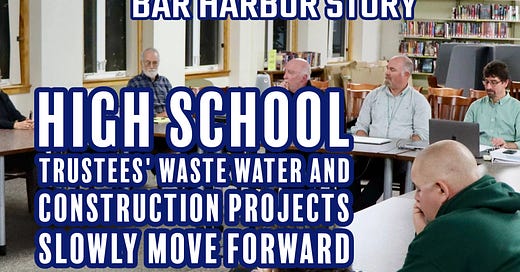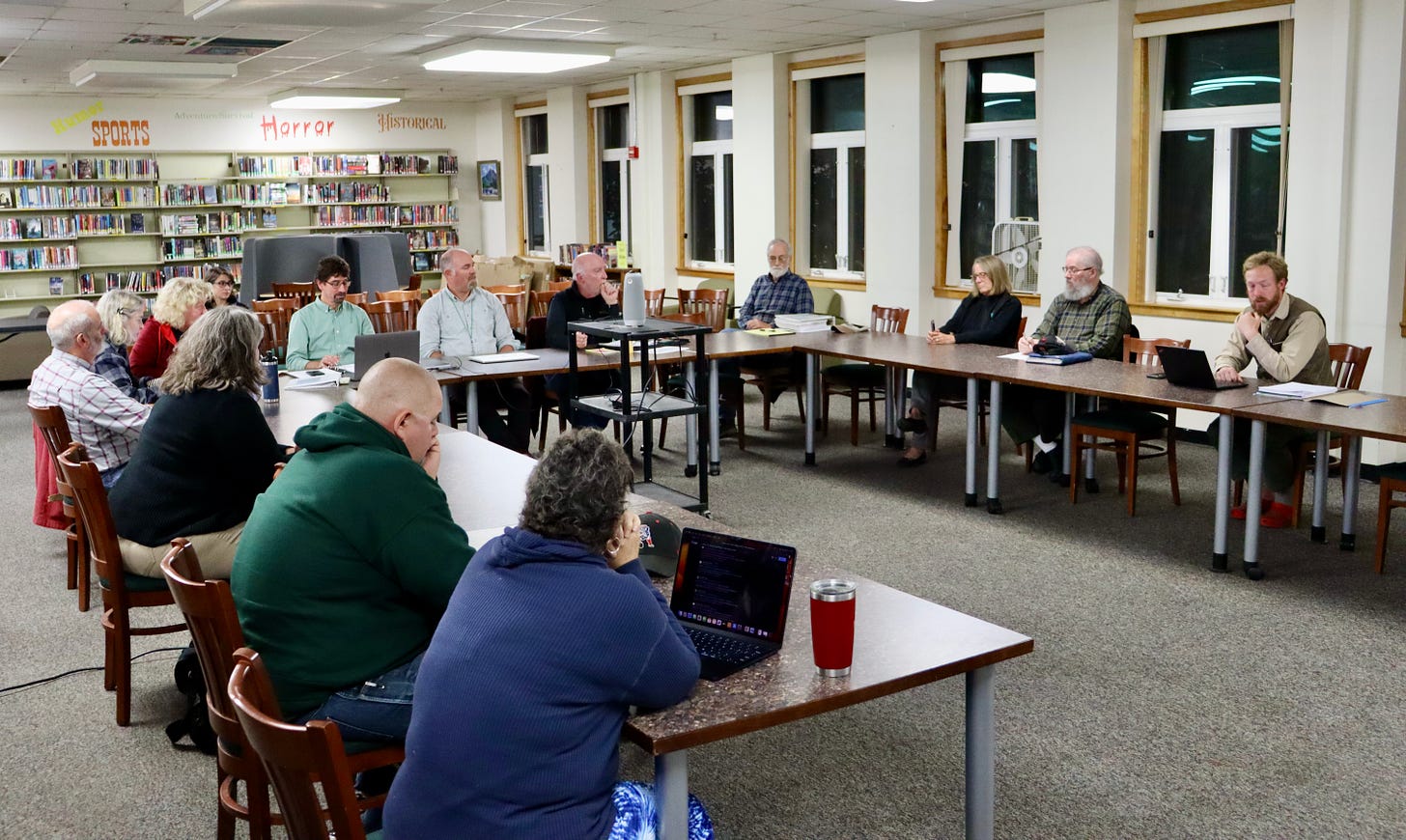High School Trustees' Waste Water and Construction Projects Slowly Move Forward
Majority of the funding for both projects would likely be from towns
BAR HARBOR––Only three major items were on the Money was on the agenda for the MDI High School Board of Trustees meeting on Monday night, October 23, and each of them had to do with money: a school construction project update, the high school’s budget, and the proposal to remediate the high school’s wastewater system.
On a less impactful side to taxpayers, Superintendent Mike Zboray told the board that the current school budget has $1.6 million in reserves and an additional $600,000 that was previously earmarked for ongoing projects.
There was then conversation about whether the $600,000 was part of the $1.6 million, but the answer was no, and that it was money that had already been asked for and budgeted. They couldn’t actually spend any of the $1.6 million in the reserve accounts.
Trustee Lawson Wulsin asked why they cannot spend the money that is in the reserve accounts.
Trustee Steve Hudson explained, “It’s in reserve accounts and the only way that we can get that money out is to ask for it at our annual meeting. We specify the amount that we want to move out but we have to ask permission to move it.”
Trustee Carole Plenty asked about the tennis court refurbishing and where that money is coming from.
It will be in next year’s budget, explained Principal Matt Haney.
HIGH SCHOOL CONSTRUCTION PROJECT
Principal Matt Haney gave an update on the school’s construction project and said that they have no new information since the last time the board talked about it. He suggested they should talk about next steps to keep this project moving forward while also having the wastewater and PFAS issues.
The school’s construction project will involve an approximately $15,914,155.00 bond referendum which would be split amongst the towns of Mount Desert Island. You can find more details about the project and the current percentage of towns’ obligations here.
Haney, Zboray, Chair Rob Jordan, and Vice Chair Ann Ratcliff had talked previously and one of the ideas that they had was to start having a round of visits and presentations at selectboard meetings in the winter or early spring. At these meetings, they could not only inform town representatives about the project but gather and/or answer questions. Then they could possibly do another round prior to whenever the board thinks would be a good time to move forward with putting the bond question on referendums.
Haney said he felt that it would be too much of a rush to try and get the project ready for this coming spring and they weren’t sure when the right time would be.
Wulsin asked Haney why he thinks spring 2024 might be too soon.
Jordan said that he was the one that had brought it up at the meeting with just Haney, Zoboray and Ratcliff. “I think based on not just the sewage treatment project that we are dealing with right now, but also based on specifically what Bar Harbor is facing. In terms of the bonds that we are looking forward to, I think politically that I think we should give them, we should have a little breathing room. I know it’s terrible to have to keep delaying it.”
Jordan went on to say that he thought they should start laying the groundwork but not put it on a referendum yet.
The group of four did feel that it is a good time to start making people aware of the high school’s needs and to give the consultants, Oak Point Associates, time to get their message together, said Ratcliff.
Trustee Keri Hayes also agreed with holding off, saying that some of the other towns on the island have bigger projects coming up right now as well.
The board unanimously decided to instruct Oak Point Associates to start preparing presentations for public information sessions revolving around the construction project for towns that are associated with the construction project. Hayes seconded.
WASTEWATER SYSTEM REMEDIATION
This portion of the meeting was attended, virtually, by Haley Ward (the consulting firm for the wastewater project) representatives Travis Noyes and Sienna Roberge. They were there to answer questions raised at the last trustee’s meeting and any questions that may have arisen at this meeting in regards to moving forward with one of the three possible remedies or a combination thereof.
The three presented solutions and their estimated costs are below.
Rehabilitate the existing lagoon-based treatment system - $267,000
Installation of a new subsurface wastewater disposal system (septic tank and leach field) - $2,506,000
Connect to the Somesville wastewater treatment plant - $5,076,000
Zboray first asked if they had heard back from the Maine Department of Environmental Protection (DEP) regarding the notice of violation (NOV) that the school had received in July of this year.
Roberge said that they have not heard back from the DEP yet regarding the notice, and they haven’t pursued DEP so as not to “poke the bear.” She also said that the school may not even be in violation at all as far as the current lagoon system is concerned.
Zboray said that they just want to make sure that they know what repairs are necessary, if any, so that they can appropriate the funds to make the repairs and get or keep the current system in compliance so that it can continue to be used while they pursue hooking into the Somesville wastewater treatment plant.
Noyes said that their position is that the current lagoon system is in compliance.
“What would be sort of a timeline in years, if everything goes well,” and what would it look like to connect to the Somesville treatment plant, Zboray asked.
Taking into account some land acquisition hold ups, Noyes said, it should take 6-8 months for design and probably 12-18 months for construction, so the board would probably looking at 2-3 years from now for it to be operational.
Hayes asked if the price tag of option three includes the cost of option one to get the lagoons compliant and to maintain their license until they can connect to the Somesville treatment plant.
The price tag of option three does not include any costs for option one, however, they feel that bringing the lagoons up to compliance, if anything is necessary, would not be as great as what they have estimated as the cost for option one, replied Roberge.
Member Chad Terry asked if they eventually built a middle school on the high school grounds, could the lagoons handle the increased usage?
Roberge and Noyes both estimated, without having investigated this question previously, that the lagoon system, especially if lagoon number three was put back into service, would be able to handle the increase in students and faculty.
To continue moving forward with the project, the board asked that Haley Ward contact the DEP and try to get an answer regarding the notice of violation so that they know if they need to spend any money to keep using the current system and maintain their DEP license.
The board was then advised on some loan and grant information that Roberge had conducted on their behalf. There were no monetary amounts given for possible grants.
Trustee Joe Cough asked about ongoing costs for wastewater disposal if they were to hook up to the Somesville treatment plant.
Noyes said that they still have more planning to do and the school hasn’t gotten to the place yet to have those conversations with the Town of Mount Desert.
How much sludge is in the lagoons is a looming, potentially large, financially based question. The disposal of sludge is very expensive and not having an estimate of that number could create a big expense that has not been calculated into current costs. Sludge removal would be necessary if the lagoons need to be relined for continued use or for decommissioning of the lagoons once the school is hooked into the Somesville treatment plant.
The lagoons are currently at a low water level and since the school can still spray, Noyes suggested that fall would be a good time to try and get those sludge estimates.
Hayes made a motion to authorize the superintendent to engage with Haley Ward to get an estimate of how much sludge is in the lagoons and the cost of sludge removal. After further conversation, Hayes amended her motion to add a figure of “not to exceed more than $10,000” for Haley Ward to determine the quantity of sludge and the cost of sludge removal.
Both motions were seconded by Hudson. The board first voted on the amending the motion which passed unanimously and then voted on the amended motion, which also passed unanimously.
The next Board of Trustees meeting is scheduled for November 27.
LINKS TO LEARN MORE
For the complete backstory on the wastewater system issues and PFAS at the high school, see the links below to previous Bar Harbor Story articles on these issues.
THE CHEMICALS THAT DON’T GO AWAY
HIGH SCHOOL BEGINS TRYING TO SOLVE WASTE WATER LEAK MYSTERY
SCHOOL WAITING ON FOREVER CHEMICAL REPORT
THE HIGH SCHOOL AND TREMONT HAVE FOREVER CHEMICALS, DO YOU?






